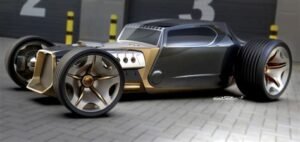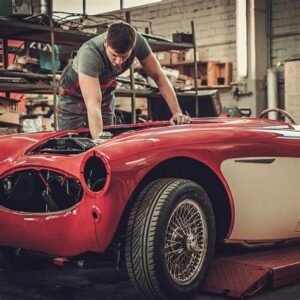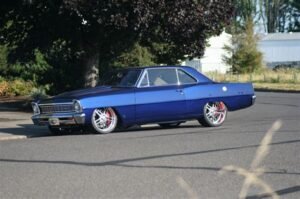
Restoration of a classic car is not only a work of love, but it is a journey back to times gone by; in fact, it requires much patience, skill, and appreciation for motor history. It’s more than just about fixing what’s broken; it’s about bringing life back into a work of art, an embodiment of times past. It involves meticulously stripping the vehicle down to its bare bones all the way to painstakingly reassembling it-a quite rewarding process that ends up with the satisfying feeling of owning a restored masterpiece.
1. Project Evaluation
Condition assessment is the first thing for any classic car restoration project. You will not only inspect the body and paint but also the engine, transmission, suspension, and interior. Understandably, knowing what to expect from the scope of work will help in indicating the feasibility and cost of the project.
1.1 Body and Paint
Begin by taking a look at the vehicle’s body for rust, dents, and scratches. Give plenty of extra attention to fenders, doors, hood, and trunk. Places to really inspect are those where rust can be apparent; any rust discovered will need attention, as it can weaken that structure and lead to further damage. Dents and scratches can be cured with bodywork; however, the amount of bodywork needed could certainly add up in cost regarding effort and money.
General bane for classic cars is rust, especially in models that have not been well cared for. Look for surface rust, which might be treated with sanding and primer, and deeper rust, which may need panel replacement. The position and extent of the rust will determine the kind of repair needed.
1.1.2. Bodywork and Paint
Once rust is dealt with, fill in any dents and scratches. This may involve the use of a filler, followed by sanding, and a primer coat to attain an even surface for paint. Depending on the extent, one may seek a professional to handle that process. The paint itself can either be stripped and repainted or repaired with touch-ups.
1.2 Engine and Transmission
Next, inspect the engine and transmission. Turn the engine on and listen for any unusual noises, smoke, or leaks. Check the level of the engine oil, coolant, and transmission fluid. Look at the belts, hoses, and wiring for any wear and tear.
1.2.1. Engine Overhaul
If it is badly performing or its wear and tear is out of the limit, it needs an overhaul. The main process should start by dissembling the engine, cleaning, then inspecting and replacing worn-out parts in order for it to get back to its original performance and reliability.
1.2.2. Transmission Inspection
The transmission just like every other part needs to be checked for leakages, problems shifting, and worn parts. Transmission rebuilding or replacement will certainly restore its smooth operation.
1.3. Suspension and Brakes
Inspect the suspension components for wear: bushings, ball joints, and shock absorbers. Check for worn-out brake pads and rotors. Inspect the whole brake line and caliper condition.
1.3.1. Suspension Repair
Changing out the wornout suspension component can improve handling, ride quality, and safety. Work can include disassembly of the suspension system, replacement of worn-out parts, and reassembly.
1.3.2. Brake System Inspection
For the sake of safety, the brake system is expected to be completely checked. So, examination needs to be done to the brake pads, rotors, calipers, lines, and master cylinder-all must be subjected to an examination. Worn components must be replaced after which the bleeding will help return the best braking performance.
2. Gathering of Parts and Supplies
After assessing what needed to be done on the car and the degree of restoration to be undertaken, the next matter for consideration is procurement. This can take a lot of time as not all original parts are available, or easily found for that matter, leave alone those that are of high quality.
2.1. Sourcing Parts
These parts can be sourced from the smallest online retailer all the way to the local salvage yard. You might also try joining online forums and clubs dedicated to your model of car to ask other enthusiasts if they have parts for sale or trade.
2.1.1. Original Parts
These are the most sought-after because they will undoubtedly fit and work properly. However, they can be very costly and hard to find.
2.1.2. Aftermarket Parts
Aftermarket parts are produced by companies that specialize in classic car parts. While they may not be exactly like the original, often they serve as a good alternative by offering quality and affordability.
2.2. Supplies
In addition to parts, you will need a number of supplies for the restoration, including:
- Tools: wrenches, sockets, screwdrivers, pliers, etc.
- Cleaning supplies: degreaser, soap, water, rags, etc.
- Protective gear: gloves, goggles, respirator, etc.
- Bodywork supplies: filler, primer, paint, sanding paper, etc.
- Engine and transmission supplies: gaskets, seals, fluids, etc.
2.3. Budgeting
Before you start buying the parts and supplies of your needs, make a financial budget. This is an estimation, and you need to take into consideration the very price each part, repair, or supply takes, including labor costs for those projects that you want to outsource to pros. This should keep you on point financially so you won’t end up being in a position that may surprise you in the least.
3. Restoration Process
The restoration process itself is very systematic, starting with dismantling the car, repairing and restoring each component, and then putting it back together.
3.1. Dismantling
First of all, one needs to dismantle the car, taking out all the parts carefully without causing any damage. It may include removing body panels, an engine, transmission, suspension, interior, and many more other parts from the car. Every single part should be labeled and pictured for their exact places when reassembled.
3.1.1. Body Removal
With the electrical wiring disconnected, hinges detached, and carefully lifted off the frame-the body panels can be removed. Protect the paint and avoid scratches.
3.1.2. Engine and Transmission Removal
Disconnecting the hoses, wires, and other cables from the engine and transmission will also prepare these components for removal. The process will include the lifting of the engine out of the bay with either a hoist or jack.
3.1.3. Suspension and Interior Removal
The suspension can be removed by removing the bolts and springs, while interiors can be stripped by removing seats, carpets, and other interior panels.
3.2. Repair and Restoration
When the car has been completely dismantled, you can actually begin to repair and restore each of its components. This may include:
- Bodywork: rust repair, dent pulling, sanding, and primer
- Paint: stripping, painting, or touch-up
- Engine: overhauling, re-building, or replacement; transmission: re-building or replacement; suspension: replacing worn parts; brakes: replacing worn parts, bleeding the system; interior: reupholstering, replacing carpets and trim;
3.3. Reassembly
You are allowed to reassemble the car after all the repairs and restoration of each component. It involves careful attachment of each part in the correct order and proper alignment.
3.3.1. Body Reassembly
The body panels are installed back onto the frame, by re-aligning the hinges and the opening and closing of the doors.
3.3.2. Engine and Transmission Installation
The engine and transmission are reinstated inside the car, along with all their respective hoses, wires, and connections.
3.3.3. Suspension and Interior Installation
Suspension components are re-attached to the frame, and the interior is installed, making sure that seats are safely attached and carpets are fitted properly.
3.4. Final Touches
When the car has been completely reassembled, you can add the finishing touches, which will include:
- Cleaning and detailing: washing, waxing, and polishing
- Testing and adjustments: firing the engine, testing the brakes and lights, and performing any adjustments
- Documentation: document the restoration process, indicating which parts have been replaced or repaired.
4. The Journey
Classic car restoration takes time, and that journey speaks of your commitment and enthusiasm. This is not about the end, but about the process-the problems one overcomes-and the pleasure felt.
4.1 Challenges and Rewards
Restoring a classic car is often challenging but very rewarding. You learn new skills, develop knowledge about classic cars, and build an example of automotive history that doesn’t exist anywhere else in the world.
4.2. Community and Events
You can further enhance the whole experience by becoming a part of the classic car community. You get to meet other enthusiasts, interact with them on issues, and participate in events like shows or rallies.
4.3. Legacy and Preservation
You are preserving automotive history with the restoration of this classic car. You make sure these beautiful and iconic vehicles keep on being enjoyed with each passing generation.
Remember, classic car restoration is a labor of love. It would entail lots of time, effort, and dedication, but the reward is incomparable. You won’t just end up with a beautiful, unique vehicle but also one that has a story to tell with it through its journey of restoration.




